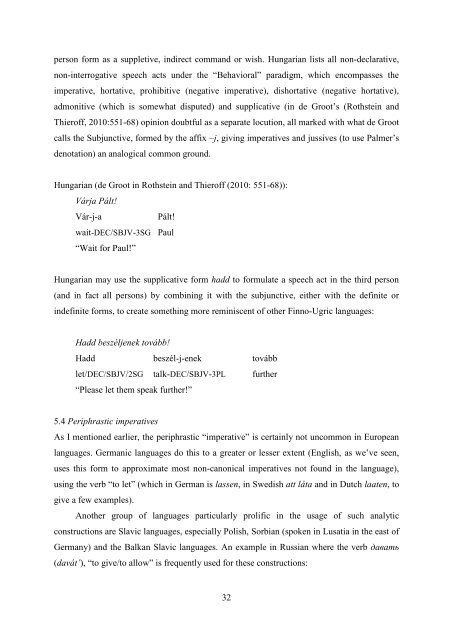The function of non-canonical imperatives in the languages of Europe
The function of non-canonical imperatives in the languages of Europe
The function of non-canonical imperatives in the languages of Europe
Create successful ePaper yourself
Turn your PDF publications into a flip-book with our unique Google optimized e-Paper software.
person form as a suppletive, <strong>in</strong>direct command or wish. Hungarian lists all <strong>non</strong>-declarative,<br />
<strong>non</strong>-<strong>in</strong>terrogative speech acts under <strong>the</strong> “Behavioral” paradigm, which encompasses <strong>the</strong><br />
imperative, hortative, prohibitive (negative imperative), dishortative (negative hortative),<br />
admonitive (which is somewhat disputed) and supplicative (<strong>in</strong> de Groot’s (Rothste<strong>in</strong> and<br />
Thier<strong>of</strong>f, 2010:551-68) op<strong>in</strong>ion doubtful as a separate locution, all marked with what de Groot<br />
calls <strong>the</strong> Subjunctive, formed by <strong>the</strong> affix –j, giv<strong>in</strong>g <strong>imperatives</strong> and jussives (to use Palmer’s<br />
denotation) an analogical common ground.<br />
Hungarian (de Groot <strong>in</strong> Rothste<strong>in</strong> and Thier<strong>of</strong>f (2010: 551-68)):<br />
Várja Pált!<br />
Vár-j-a<br />
Pált!<br />
wait-DEC/SBJV-3SG Paul<br />
“Wait for Paul!”<br />
Hungarian may use <strong>the</strong> supplicative form hadd to formulate a speech act <strong>in</strong> <strong>the</strong> third person<br />
(and <strong>in</strong> fact all persons) by comb<strong>in</strong><strong>in</strong>g it with <strong>the</strong> subjunctive, ei<strong>the</strong>r with <strong>the</strong> def<strong>in</strong>ite or<br />
<strong>in</strong>def<strong>in</strong>ite forms, to create someth<strong>in</strong>g more rem<strong>in</strong>iscent <strong>of</strong> o<strong>the</strong>r F<strong>in</strong>no-Ugric <strong>languages</strong>:<br />
Hadd beszéljenek tovább!<br />
Hadd beszél-j-enek tovább<br />
let/DEC/SBJV/2SG talk-DEC/SBJV-3PL fur<strong>the</strong>r<br />
“Please let <strong>the</strong>m speak fur<strong>the</strong>r!”<br />
5.4 Periphrastic <strong>imperatives</strong><br />
As I mentioned earlier, <strong>the</strong> periphrastic “imperative” is certa<strong>in</strong>ly not uncommon <strong>in</strong> <strong>Europe</strong>an<br />
<strong>languages</strong>. Germanic <strong>languages</strong> do this to a greater or lesser extent (English, as we’ve seen,<br />
uses this form to approximate most <strong>non</strong>-ca<strong>non</strong>ical <strong>imperatives</strong> not found <strong>in</strong> <strong>the</strong> language),<br />
us<strong>in</strong>g <strong>the</strong> verb “to let” (which <strong>in</strong> German is lassen, <strong>in</strong> Swedish att låta and <strong>in</strong> Dutch laaten, to<br />
give a few examples).<br />
Ano<strong>the</strong>r group <strong>of</strong> <strong>languages</strong> particularly prolific <strong>in</strong> <strong>the</strong> usage <strong>of</strong> such analytic<br />
constructions are Slavic <strong>languages</strong>, especially Polish, Sorbian (spoken <strong>in</strong> Lusatia <strong>in</strong> <strong>the</strong> east <strong>of</strong><br />
Germany) and <strong>the</strong> Balkan Slavic <strong>languages</strong>. An example <strong>in</strong> Russian where <strong>the</strong> verb давать<br />
(davát’), “to give/to allow” is frequently used for <strong>the</strong>se constructions:<br />
32
















